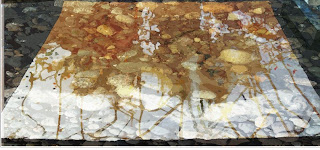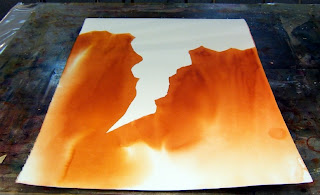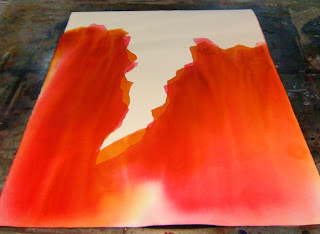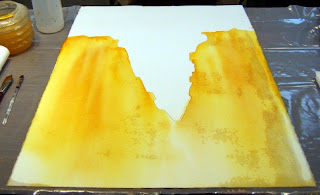My memory is horrid! My television is in the livingroom upstairs - my art room is downstairs. I watch a bit of the DVD, then go down and start doing the next step...and forget the next step! Of course, a LOT of time is spent waiting for the paper to dry to a certain stage and as damp as it is here, that's taking about 45-55 minutes each time.
These next few steps are (see previous post for steps 1 - 6):
7. Using a strong mix of Ultramarine Blue + Dioxizine Purple (more blue than purple) on your palette, you then brush on the color, wetting it well and tilting the paper again to let it blend and merge with the other colors. (You could pour this mix if you prefer). Blot up the color where you want to show the underlying color more (the Phthalo Blues and Quin Golds and Raw Siennas).
8. Make water drops after this has dried a bit (sheen is off the paper and it's about 75% dry). Then spritz off the paint if you want to create more batik effects (at this point my paint had dried too much to make water drops or spritz but I have an excuse = I was having a horrid migraine so left the painting sit too long).
9. After the last colors dry, mix up a bit of Raw Umber + Ultramarine Blue on your palette and, using a tiny brush, you'll make rivulets on the paper. You do this by 1st putting clean water in the brush and smooshing it on the paper, making runs of clean water - then you take the pigment in the brush and touch it, allowing it to run and create some more interesting looks. You can blot up the runs if you don't like them and you can just paint them in but be careful you don't go too dark. Pay attention to the background color and make the rivulet colors fit in with that.

10. When everything is dry, remove the masking fluid from the leaves/stems only, leaving the fish covered. Then reapply masking fluid around the edges of the tape and let that dry.
At this stage, you are ready to mix up some greens and golds and blues and browns on your palette and start painting the leaves/seaweed stuff. Nick says he likes to use bright colors first because you can tone/mute them later but can't brighten up dull, dried acrylics. So start light and bright with your color choices.
I'm hoping I'll get some time to work on this later today and get the leaves/seaweed done - but I have cleaning to do (seems like I just did this last month and it needs it again! ha ha)
I really recommend this DVD to learn this technique and learn what a good teacher Nick Simmons is - he is very relaxed and it's like he's just standing in front of you showing you this painting style. So far my only nitpick is my own fault = I haven't been able to create the batik look he's trying to teach me! Next time I may use a hairdryer and dry areas so I know there are dry and damp parts of the paper to work on to get the batik look.


















































